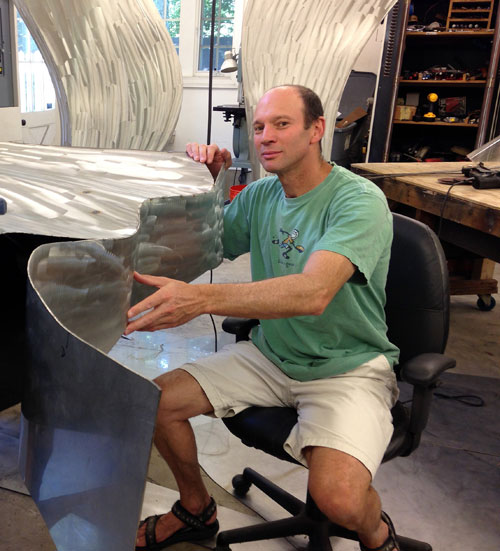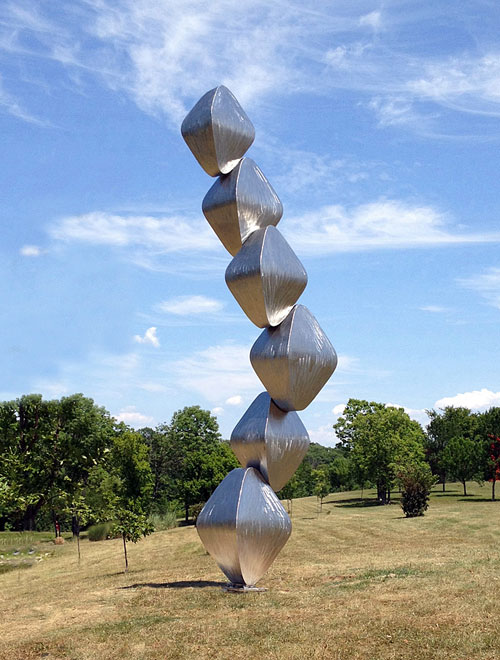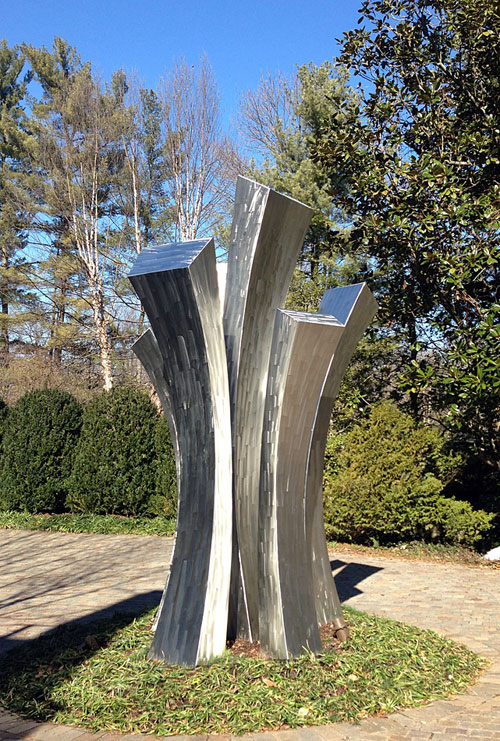Art, // March 13, 2016
Barton Rubenstein — ARTIST
Interview with artist Barton Rubenstein —
1. Who are you and what do you do?
My name is Barton Rubenstein. I began creating sculpture full-time in the early 1990s. Previous to that, I was a neuroscientist. Despite loving the world of science, studying physics and visual perception, I gradually began to miss my other love, which was working with my hands and creating.

Dare To Be
VIDEO
“Dare To Be” © 2014 Stainless Steel (Wind Kinetic Sculpture) Three Elements: 10’ H x 4’ W x 1’D
Using a kinetic mechanism invented by the sculptor, this artwork moves back and forth in the slightest breeze. “Dare To Be” was created for two different venues. The first venue is a large residential community. The second venue is a school, where the slightly smaller scale artwork (8’ H) is located in a central plaza overlooking the Washington Monument in the distance.
2. Why art?
Originally, as a kid, I spent my creative time working on projects around the house and in various art classes. I found value and enjoyment in both activities; the act of creating and sharing was always the fuel. Gradually, art and sculpture became my focus, particularly when I discovered I had a knack for creating original designs, which was augmented by my scientific and engineering skills. On a more philosophical dimension, I chose the world of art because it has a more penetrating influence on our lives. It inspires and lifts the human spirit like nothing else, except music. I actually also compose on the piano. I consider musical composition the highest form of art, but because I feel I have more talent in the world of sculpture, I chose that path. As an aside, Mozart always considered himself an operatic composer. I suppose he felt creating opera was an even higher form of art!
3. What is your earliest memory of wanting to be an artist?
I always enjoyed art, even as a very young child. I remember as a 4th grader doing a charcoal of a snowy tree in winter that was placed in a school calendar, which gave me a great deal of satisfaction. I also spent a lot of my youth creating large-scale snow sculptures with my dad and sisters. I always enjoyed the viewers’ (passing cars and pedestrians) reactions to our creations, which continues to this day.
“Skybound” © 2012 Stainless Steel 30’H x 7’W x 7’D
This sculpture uses unique engineering to create the impression of shapes floating in space and climbing toward the sky. The six elements are positioned on top of each other, without any visible connections.
Created for the Pyramid Hill Sculpture Park, Hamilton, OH
4. What are your favorite subject(s) and media(s)?
My first love was mathematics and studying nature. I have always loved staring at trees and the movement of rivers. Despite working with clay as a young child, I found the results not very promising. Then, influenced by my mother who was a curator at the Smithsonian, I tried the graphic arts, including linoleum, woodcut, etching, and lithography. Although I was skilled at these media, I felt my ability to express was somehow limited. It turned out I missed the third dimension. When I returned to the 3D world, I transformed my skills of woodworking (i.e., home projects) into the metal world of stainless steel and bronze.
Presently, my three genre of sculpture are water sculpture, wind kinetic sculpture, and sculpture in suspension. Water sculpture was definitely my original focus and my early success is reflected by Google ranking my website at the top of the list for “water sculpture” (over 50 million hits).
5. How do you work and approach your subject?
I design and fabricate all of my work. I typically create line drawings of my designs, followed by paper or metal models. Then in the studio, working with plasma cutters, welding machines, and grinders, etc., I bring my artwork to fruition. My artistic life is purposely balanced with creative thought and physical labor. The designing is what fuels my creative energy and the physical labor is what keeps me sane.
“Synergy” © 2010 Stainless Steel (Water Sculpture) 12’ H x 30’ Diameter
Situated at the center of the common space of University of Connecticut Waterbury, this water sculpture accentuates its smooth curving surfaces and sheets of water that glide off its edges. The main thrust of the design is that each of the five water sculptures represents a human form. From afar, these human forms appear similar. However, closer inspection reveals unique attributes, including different heights, shapes, orientation, and water patterns.
6. What are your favorite art work(s), artist(s)?
As I have visited many museums in my lifetime (many as a reluctant kid), I have many influences that have either consciously or unconsciously guided my thought process. For different reasons, Henry Moore and George Rickey are major influences in my artistic life. I obviously was also attracted to David Smith’s stainless steel sculptures, remembering vividly as a child seeing an exhibition of his at the newly finished East Building of the National Gallery of Art.
7. What are the best responses you have had to your work?
I have been fortunate to receive a tremendous amount of positive feedback and encouragement during my career as an artist. I am particularly excited when I create a work of art for an academic institution, because this is where I feel my art has the most impact. I feel this impact by the variety of responses and interpretations I hear from the students and faculty. “We are still enjoying our own sculpture (‘Synergy’) at the UConn campus and I’ve often heard students remark about the peaceful atmosphere they enjoy when they have time to sit and observe.”
“Cosmic” © 2016 Stainless Steel 11’H x 7’Diameter
Six curvilinear shapes rise and explode upwards in a cosmic expression of Albert Einstein’s “spacetime.” The acceptance of spacetime, connecting space and time as interconnected dimensions of our universe, was further strengthened the year of this installation, 2016, by the discovery of gravitational waves. This marks 100 years since Einstein predicted it in his theory of General Relativity. Created for a private residence, Bethesda, Maryland.
8. What do you like about your work?
First, I love the permanence of my work. Having spent my youth creating snow sculptures that would melt in the following days, I finally feel that my hard work and expression will no longer be literally washed away! I also like the simplicity of my designs. I originally experimented with complex ideas, but found that simple lines and elegant shapes are the foundations of aesthetics. My hope is that there will be appeal for my artwork in the present and long into the future. I imagine a man looking at my sculpture 1000 years into the future in the same way as I look at art from 1000 years ago.
9. What advice would you give to other artists?
The three most important things an artist must have is:
1) You must live and work surrounded by a community of encouragement.
2) The artist must find something inside that needs to be expressed. Once you have found this and hopefully it is unique, then you must spend a career “with your eyes down on the pavement,” i.e. not distracted by outside negative influences.
3) You must explore many things outside of the world of art. The more diverse your education and knowledge base, the more you can bring to your art.
“Man and Earth” © 2015 Stainless Steel
This sculpture has been chosen by the Smithsonian Institution’s National Portrait Gallery, as the Portrait of a Nation Award, given at the annual gala event to honor “Great Americans.”
The inaugural 2015 event honored baseball legend Hank Aaron, singer Aretha Franklin, artist and architect Maya Lin, Corporal Kyle Carpenter, and fashion designer Carolina Herrara.
In September, 2015, the City of Jerusalem accepted a proposal to display a 16′ high “Man and Earth” in a prominent public space at the center of the city.
10. Where do you see yourself in 5-10 years?
I hope to be doing the same, designing and creating. One of the most impressive things I observed at the beginning of my career occurred while spending the day with sculptor George Rickey. At the time, he was a man in his eighties with child-like eyes and he moved around the studio with light feet and excitement. Seeing him like that was the moment I chose to become a sculptor full time. I too wanted to choose a life’s work that would carry me into my eighties with energy and purpose!
LINKS —
Website: www.RubensteinStudios.com
Website Videos: http://www.rubensteinstudios.com/videos/
Facebook: https://www.facebook.com/BartonRubensteinStudios?ref=br_tf
Instagram: https://www.instagram.com/BartonRubensteinStudios/?ref=badge
Twitter: https://twitter.com/bartsher
YouTube: https://www.youtube.com/results?search_query=barton+rubenstein








